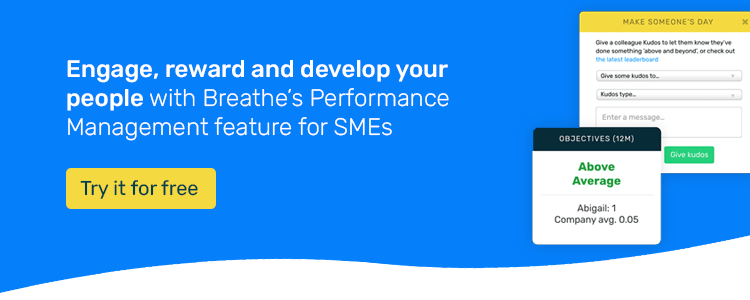In this guest blog, Lucy Adams talks about where she is now and her wealth of experiences, focusing in on the topic at the top of HR, SME and manager agendas – performance management.
From former BBC HR Director to CEO of Disruptive HR, Lucy understands firsthand that in today’s fast-paced and disruptive world, traditional approaches to performance management are proving to be increasingly ineffective.
As someone who has spent a lot of time in HR, both in major organisations and within my own business, I've seen how annual objectives, rigid feedback cycles, and measuring performance can often miss the mark in today’s dynamic work environment. It’s important for people to understand why these traditional methods may not always work.
That’s why I’m going to share my experiences with you, as we delve into why these traditional methods fall short - and explore real changes that organisations can implement to drive better performance and employee engagement.
The starting point
Businesses spend a lot of time (alongside multiple processes) on performance management and ask a lot from their employees and managers. But, does it work? Are we getting it right? And are employees feeling motivated?
When I was at the BBC, we reviewed our processes – changing ratings, how many pages our performance reviews were and making it (what we thought) was more slick and easy.
But, when delivering a presentation, I was met with questions to why I was bringing something to the table that was seen as demotivating. I couldn’t believe it at the time - I genuinely thought I’d come up with something to really help the team.
I knew I wasn’t alone, in the past HR has always followed a structure – which this was. But actually – all I had done was create more paperwork in a different way. Over the years, we’ve tended to focus on training people to complete this paperwork, rather than thinking about what this actually does to or for people.
The good news? Things have been and are changing – in a big way. So, let’s take a look at the traditional approaches and what the alternative ways of doing things looks like.
Annual objectives - a waste of time
Traditional objective setting has long been a staple for performance management. However, this reporting cycle simply doesn’t align with the dynamic nature of today's world. By clinging to annual objectives, you can hinder rather than drive performance.
So what's wrong with annual objectives?
Annual objectives can’t keep up with the rapid pace of the world today – what made sense in January as an objective, is most likely to be entirely irrelevant by December.
Another reason we know this doesn’t work is that, come appraisal time, you’ll find managers and employees asking for copies of their objectives, as they’ve forgotten where they’ve been saved or even what they agreed as objectives (because it was that long ago).
Realistically, objective-setting needs to be done regularly. We don't need to necessarily reflect with the annual business reporting cycle. Just because certain annual business reviews and reports work for a business – doesn’t mean applying this to people will work.
That’s why the alternative approach of refreshed, relevant and immediate objectives is what will lead to business and people successes.
The dreaded annual review
In the webinar I recently worked on with Breathe, we ran a poll to understand the biggest challenge our audience face when it comes to current approaches to performance management, and top of the results – managers don’t like doing them.
And it’s understandable, they’re time-poor, they struggle with conversations that go alongside these processes and they have to cram extra meetings into their diaries – but most importantly, they don't believe that they will help them improve performance.
But if you give them tools that work and are helpful for their teams, I’ve found, that they will use them.
One of the big tasks often put on manager’s shoulders, are the dreaded annual appraisals. Where they book a meeting room and sit down and say “I am going to give you some feedback” – the eight words to make any employee shudder. And – it’s a pointless exercise. As humans, we can only change one behaviour at a time. So being tasked with changing numerous things won’t happen.
Feedback needs to be in the moment. And secondly, this way of working leads to employees being far more defensive rather than open, as it comes across as being told what to do (in a similar way to the parental dynamic).
Ratings - falling short in performance assessments
Ever had a rating when you’ve had a great review and you’re hit with ‘meets expectations’? It’s like a punch in the gut for anyone’s morale. It brings a sense of disappointment – but why, when you’ve probably had a good year? Why are companies doing this? It tends to be bonus-related.
"But judging people and giving them a number for a year's worth of work isn't an effective mechanism for measuring performance."
Measuring performance is a hard task, typically because it’s very subjective. And as managers, many are subject to rater bias – which actually comes down to people just being human beings and the way we’re built. Even if we think we’re unbiased, there are inherent biases present in our assessments - so the data isn’t reliable and the numbers don’t actually mean much.
I used to have a client, who operated a system where if employees got two lowest-rating appraisals in a row, then they were immediately put on a performance improvement plan. To play it out, the manager would just share the lowest rating each appraisal between the team, so it meant that none of their employees would have to be put into that position. It's just one example amongst many where we focus on the system rather than performance.
The 3 alternatives you need to try
1. Employee-owned
So whilst managers have been owning objectives and managing employee reviews, ask yourself this - can people actually manage someone else’s performance? Surely it’s down to the individual whether they’re going to perform or not.
Yes, individuals will need support and coaching, but in the end, it’s about an employee’s will and desire to shape their performance.
"It's time to move away from performance management as being something that is done to you, to something that the individual owns and drives."
Here’s an example. Vistaprint got rid of all appraisal ratings, forms, annual cycle and said instead, that every employee is responsible for their own feedback. They need to ask colleagues, managers and people they work with for feedback – and the manager’s role?
To help make sense of the feedback the employees are receiving. Rather than a once a year exercise to the person, people can do this for themselves, with the flexibility of doing this as often as they’d like.
River Island have adapted a similar style and have found this really works to also support career development. This helps drive people’s motivation to own their career and talk about where they want to go, rather than employee’s saying something like “Oh, I haven’t been given a career development meeting.”
When companies encourage employees to ask for feedback and give them the reins to steer their own development, it creates an environment where everyone's able to constantly improve.
2. Focus on the team
Rather than always focusing on one-to-ones and the individual, we know that work happens in teams. So rather than thinking about individual performance management, consider the team performance and put your focus into this.
Buffer are a great example of this. They say that goal setting at a team and organisation level is incredibly collaborative. So rather than cascading down, employees can contribute to the overarching goals – giving space to discussions and debate. These goals are often reviewed regularly at a team level.
It’s a great place to start and can be followed by team reviews. So instead of reviews being done on a one-to-one basis, you can review team performance as a team.
Here’s an example that I experienced working at the BBC. The News at 10 team were a really high-performing team and I was curious to see what they were doing, compared to other teams that had lower performance.
One of the key things they did, was a regular review as a team about their performance. They would meet after the news had gone out and question how it had gone between them. The big factor? The team leader would start with themselves, by critiquing their own performance within the team. What impact did this have? It created an environment that was psychologically safe to review their own performance. A sophisticated peer-to-peer review, in an honest and transparent way set by the tone of the leader.
3. 'Process-lite' and agile
It’s time to get rid of bureaucracy, get rid of the annual cycle, get rid of the paperwork, get rid of the ratings and instead, focus on human interactions. That’s where performance improvement comes from, your people – not traditional frameworks.
Whether it’s manager’s helping employees with course correction or employees asking for feedback, creating fluid performance management is what actually works.
A great organisation example to share that are doing this well, includes Adobe. Adobe tried to make small tweaks and changes to the traditional system but in the end, decided to get rid of this (especially for all the time wasted making changes that just weren’t working). So they got rid of documentation (and for those thinking – but what about poor performers? Yes, if you have a poor performer, do document everything you need to. Remember, this is likely to be a very small percentage of any employees).
And at Atlassian, they’ve got rid of the documentation too and they focus on weekly check-ins instead, with manager’s asking their employees 3 simple questions:
- What are your priorities?
- How can I help you?
- How are you feeling?
These are the types of questions that genuinely help to improve performance and consider the employee as a human being. This performance management style shows how companies don’t need to overcomplicate things.
Convincing people it's time for change
Fortunately, there are real changes here to stay for performance management. If you’re someone trying to persuade your leaders or need help to steer your company to change, there are some great stats out there to help push this over the line.
Here’s why traditional performance management doesn’t work:
-
It's time-consuming & costly (estimated £300 pp per year)
-
It doesn’t motivate people – 80% of employees aren’t motivated (Gallup)
-
It doesn’t improve performance – 80% of companies don’t believe traditional approaches work (Gartner)
-
Most companies are now making changes to their performance management – nearly 70% (McKinsey)
Bringing it together
If you’re looking to move away from traditional performance management, it could be worth piloting one small area first, so you’re not tackling everything at once. Sometimes changing things all at once or too quickly can feel overwhelming to employees.
Before changing any outdated practices you currently use, consider your main objective. Think about who owns this, how you’ll set objectives moving forward, what frequency you’ll review performance management and if you’ll kick ratings to the curb or even ditch the documentation.
Once you’ve got a clear purpose to your performance management, you’ll be able to embrace flexibility, feedback and continuous improvement, unleashing your business and people’s full potential. Remember – it’s about approach, not process.
Breathe’s performance management tools can help with all your performance needs, with employee tracking, one-to-one bookings and goal-setting. Find out more or take out a free 14-day trial, today.

Author: Lucy Adams
Lucy Adams, the founder and CEO of Disruptive HR, brings over a decade of experience in Board-level HR positions, including her recent tenure at the BBC. Blending strategic and operational HR knowledge with a novel yet pragmatic perspective, her goal is to reintroduce the essence of "human" into Human Resources.





